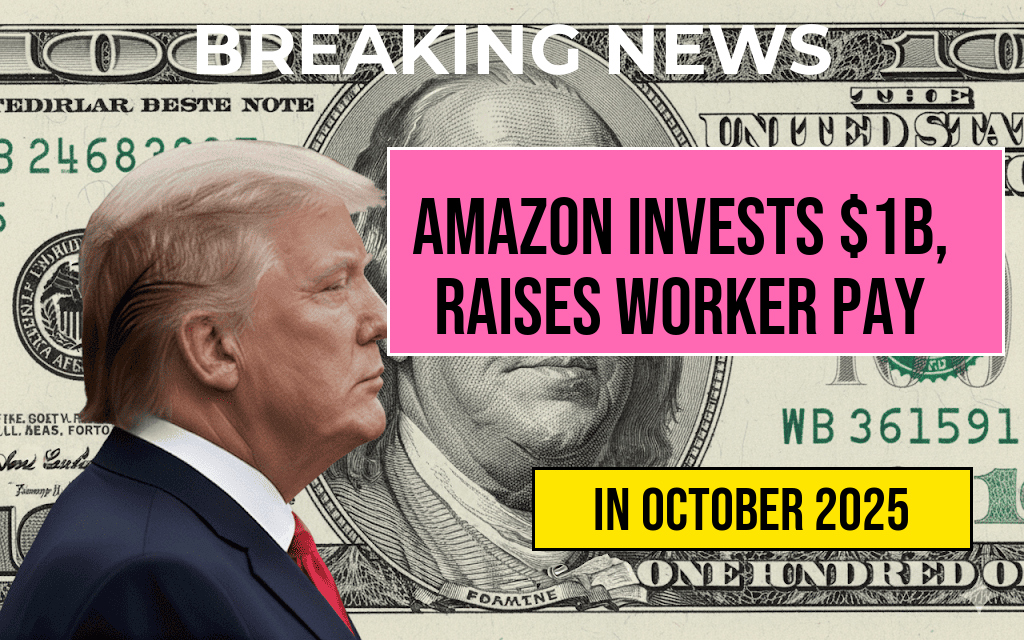Amazon’s recent $1 billion investment in its fulfillment network has led to a significant boost in worker compensation, elevating the average hourly pay for fulfillment center employees to over $23. This move underscores the company’s ongoing strategy to improve workforce stability amid rising operational costs and increasing competition in the logistics sector. The company’s decision to increase wages reflects a broader effort to attract and retain skilled labor, address worker concerns about pay equity, and maintain its reputation as a leading employer in e-commerce logistics. With this investment, Amazon aims to bolster productivity, reduce turnover, and solidify its position in a fiercely competitive market where labor costs are a critical factor. The wage hike also comes amid ongoing discussions about working conditions and labor rights within the industry, positioning Amazon as a more attractive employer compared to other giants like Walmart and FedEx.
Impact of the Investment on Wages and Workforce Stability
Since announcing the $1 billion commitment, Amazon has reported that the average hourly wage for its fulfillment workers has surpassed $23. This increase represents a substantial rise from previous levels, which hovered around $18 to $20 per hour in many regions. The company attributes the wage boost to its ongoing efforts to enhance employee satisfaction and reduce turnover rates, which have historically been high in logistics and distribution centers.
According to internal data, the wage increase has contributed to a decline in employee attrition rates, allowing Amazon to maintain a more experienced and efficient workforce. Industry analysts note that higher wages are likely to improve morale, reduce training costs, and increase overall productivity. Workforce management strategies that include competitive pay are increasingly seen as essential for long-term operational success, especially as Amazon expands its global footprint.
Regional Variations and Pay Equity
The wage increase is not uniform across all fulfillment centers. Amazon has tailored compensation packages based on regional labor markets, with some facilities in high-cost areas like California and New York seeing wages approaching or exceeding $25 per hour. In lower-cost regions, the average pay still surpasses previous levels, but the increase is more modest.
| Region | Previous Average Pay | Current Average Pay | % Increase |
|---|---|---|---|
| California | $20 | $25 | 25% |
| Midwest | $18 | $22.50 | 25% |
| Southern States | $19 | $23 | 21% |
Despite regional differences, Amazon emphasizes that the overall trend reflects a company-wide commitment to providing competitive wages. Critics, however, argue that the pay increase, while substantial, still falls short of addressing broader concerns about working conditions, safety, and the physical demands placed on fulfillment workers.
Broader Industry Implications
Amazon’s wage hike has ripple effects across the logistics and e-commerce sectors. Competitors like Walmart and FedEx have also been revising their pay scales, recognizing the importance of offering attractive wages to secure a stable workforce. According to Forbes, these adjustments are part of a broader trend where companies are investing heavily in labor to meet increasing consumer demand and ensure timely deliveries.
Labor experts point out that such investments could help reduce the substantial turnover rates that have plagued warehouse operations nationwide. The warehouse management industry faces ongoing challenges in maintaining experienced staff, which affects operational efficiency and customer satisfaction.
Worker Perspectives and Industry Challenges
While Amazon’s wage increase is a positive step for many fulfillment workers, some industry advocates argue that pay raises alone do not address systemic issues such as physical strain, mandatory overtime, and workplace safety. Workers have voiced concerns about the pace of work and the pressure to meet demanding productivity targets.
Labor unions and advocacy groups continue to push for comprehensive reforms, including better safety protocols and more predictable schedules. Amazon has announced initiatives aimed at improving working conditions, but critics remain cautious, emphasizing that pay increases should be part of a holistic approach to worker well-being.
Economic Context and Future Outlook
The investment and resulting wage increases come amid a complex economic landscape marked by inflationary pressures and fluctuating consumer demand. As e-commerce sales continue to grow, Amazon and competitors alike are adapting their labor strategies to balance cost management with workforce needs.
Market analysts expect Amazon to maintain its focus on wage competitiveness, especially as it strives to meet ambitious delivery timelines and expand its logistics capabilities. The company’s ability to attract and retain skilled fulfillment workers will likely influence its operational efficiency and profitability in the coming years.
For more insights into Amazon’s labor strategies and industry trends, see logistics industry overview and recent reports from Forbes.
Frequently Asked Questions
What is the main purpose of Amazon’s one billion dollar investment?
Amazon’s one billion dollar investment aims to improve the compensation and working conditions of fulfillment workers, resulting in an increase in their average pay to over twenty-three dollars per hour.
How has Amazon’s investment impacted fulfillment workers’ wages?
Thanks to the investment, the average pay for fulfillment workers has risen to over twenty-three dollars per hour, providing better earning opportunities for employees in these roles.
What are the potential benefits of increased pay for Amazon fulfillment workers?
Higher pay rates can lead to improved job satisfaction, increased employee retention, and a more motivated workforce, ultimately benefiting Amazon’s fulfillment operations.
Does the investment include other improvements besides wage increases?
While the primary focus is on raising wages, Amazon’s one billion dollar investment may also support enhanced benefits and working conditions for fulfillment workers.
How does Amazon’s investment compare to industry standards for fulfillment workers?
With an average pay exceeding twenty-three dollars per hour, Amazon’s investment positions it as a leader in offering competitive wages within the fulfillment industry.

Leave a Reply